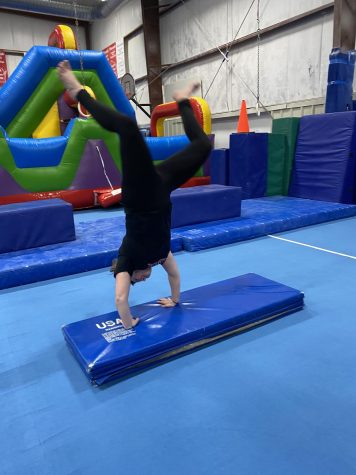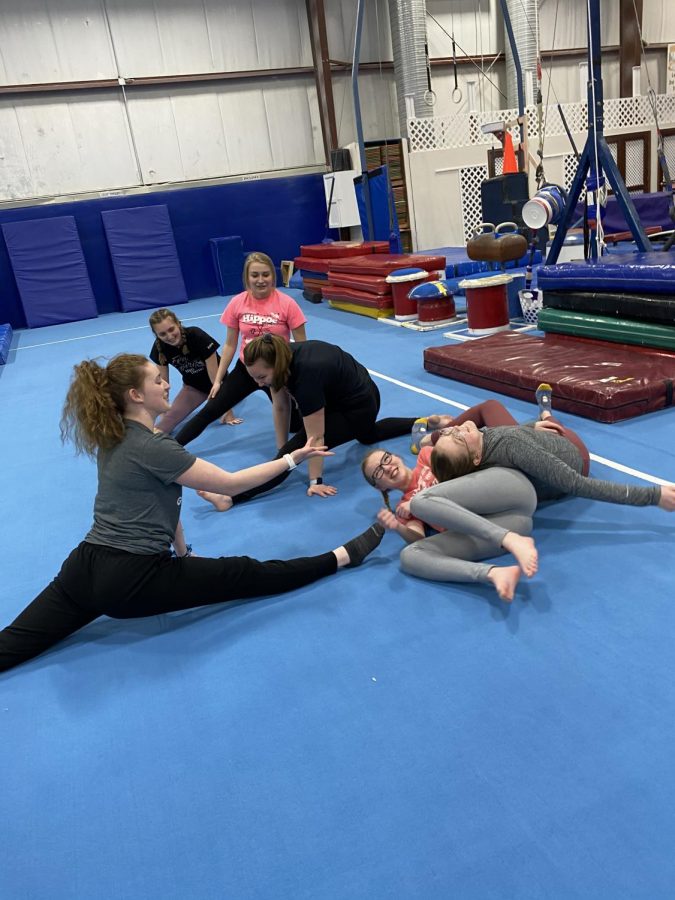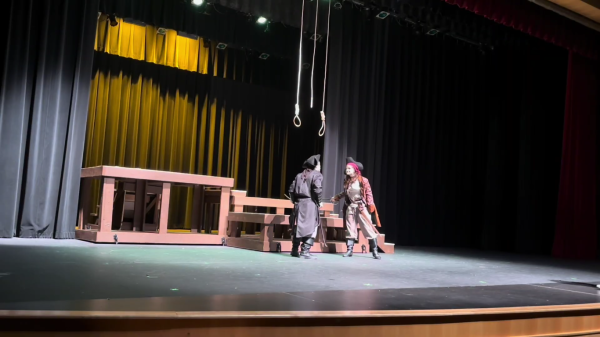Fondy Athletes Trade Sports
What happens when a runner and a swimmer try gymnastics?
Every athlete puts immense effort into perfecting their craft. They come in early to lift weights and condition and practice for hours on end after school.
When people are younger it is much easier to participate in many activities and try their hand at different sports: soccer on Monday, football on Tuesday, softball on Wednesday. By high school, most people narrow down their participation to just one or two sports to devote themselves to becoming better players.
But what happens when you take athletes out of their comfort zone and force them to try sports they have never practiced? We took athletes with entirely different skill sets and had them try their hand at something completely different for them: gymnastics.
Natalie Lord and Amber Franzen are both distance runners for the Cardinal Cross Country squad and track team, and Megan Roerhig is a member of the swim and dive team. Their sports are similar to gymnastics in that an athlete competes as an individual in multiple events. That is about where the similarities stop.
Running and swimming are both aerobic sports that require virtually no equipment. Gymnastics on the other hand is an acrobatic sport that requires the use of various equipment for events such as the balance beam or uneven bars. This can be difficult because the athlete has to learn how each piece works and how to use it most effectively for their body. Gymnasts must have every body part, down to the pinky toe, placed perfectly in order to get the right rebound off the floor exercise or the correct amount of swing on the uneven bars.
 Also, where swimming and running events are just different distances or strokes, gymnastics has events that are distinct from each other, but are often mixed up.
Also, where swimming and running events are just different distances or strokes, gymnastics has events that are distinct from each other, but are often mixed up.
“Which one is this, the bars?” Lord questioned before taking to the balance beam.
Gymnastics is also different in that winners are not based off speed, but on which athlete can be most perfect. In a competition gymnasts will start from a 10.0 and judges deduct points for errors throughout the routine.
Lord, Roehrig, and Franzen were not quite at the skill level where they could perform for a judge. Roehrig took some gymnastics lessons as a child, but neither Franzen nor Lord had any experience whatsoever.
“I can do a cartwheel,” Franzen said, “but not the one where you land with your feet together, that scares me.”
The girls weren’t sure if their experience as athletes or any of their skills would transfer over into a sport so different.
“I think the bars will be very difficult because I haven’t built very much upper body strength as a runner,” Franzen said, “but I feel like I’d be stronger on vault because I can use my running and lower body strength to help me jump off the springboard.”
Those strengths were put to the test when they traveled to Precision Athletics in Oshkosh. The girls worked with owner and team coordinator Taylor Ames and other recreational coaches to evaluate their skills and try to learn new ones.
They started with a simple warm-up by jumping on the trampoline before running through a stretching routine. The girls tried their best at stretches like pike, splits and bridges, but none were very flexible. Only Franzen was able to reach her toes in the pike stretch, and none were quite able to master either of their splits.
Then, the ladies took to the floor exercise. The first move they attempted was a basic forward roll. All were able to accomplish it, but it was somewhat of a struggle for them to properly tuck their head and stand up to a finish position. They also worked on other simple tumbling skills such as cartwheels and roundoffs.
On the balance beam they stuck to very straightforward concepts such as mounting the beam, walking in different directions and straight jumps. Their fear was evident on their faces as they attempted to jump on the four-inch beam four feet off the ground.
Vault lessons consisted of learning springboard control and straight jumps onto a resi pit, and the goal on the uneven bars was to master a pullover mount. The bars and vault were a struggle for all the athletes who were not used to coordinating their bodies with the movement of the equipment.
The new ways they had to use their muscles caused their bodies to ache for the next several days.
“It’s two days later now and I’m still sore,” Franzen said.
All of the athletes came to a consensus that none of their athletic skills transferred over to an acrobatic sport. They also found it difficult that they had to build new skills off one another to be able to improve. They first had to master a cartwheel before they could attempt a roundoff and so forth.
“With swimming you can just get into a pool and swim, or cross country just start running,” Lord said, “but with gymnastics you really need to have that background and confidence that ‘yes I can do this thing’ to be able to try something new.”
Lord, Franzen and Roehrig proved that athletic ability does not necessarily transfer to every activity. After years of specializing and perfecting their skills in one discipline it was hard for them to use their bodies in different ways, and sometimes frightening to try something they weren’t comfortable and familiar with. Athletes put themselves into a bubble where their body and brain knows exactly what to do, and stepping outside that bubble is like a brand new world.
Still, they had fun trying their hand at something utterly opposite to their normal physical activity and learning new skills to take forward with them.

Rachel is a second year staff member on the Cardinal Columns, currently serving as the sports editor. Rachel has been a competitive gymnast for 11 years....











